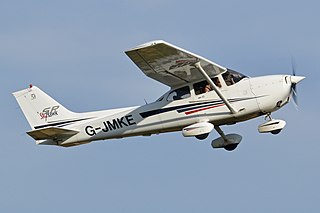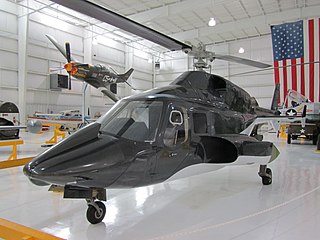Related Research Articles

An aircraft is a vehicle that is able to fly by gaining support from the air. It counters the force of gravity by using either static lift or the dynamic lift of an airfoil, or, in a few cases, direct downward thrust from its engines. Common examples of aircraft include airplanes, helicopters, airships, gliders, paramotors, and hot air balloons.

A vertical take-off and landing (VTOL) aircraft is one that can take off and land vertically without relying on a runway. This classification can include a variety of types of aircraft including helicopters as well as thrust-vectoring fixed-wing aircraft and other hybrid aircraft with powered rotors such as cyclogyros/cyclocopters and gyrodynes.

Flight or flying is the process by which an object moves through a space without contacting any planetary surface, either within an atmosphere or through the vacuum of outer space. This can be achieved by generating aerodynamic lift associated with gliding or propulsive thrust, aerostatically using buoyancy, or by ballistic movement.

The history of aviation spans over two millennia, from the earliest innovations like kites and attempts at tower jumping to supersonic and hypersonic flight in powered, heavier-than-air jet aircraft. Kite flying in China, dating back several hundred years BC, is considered the earliest example of man-made flight. In the 15th-century Leonardo da Vinci created several flying machine designs incorporating aeronautical concepts, but they were unworkable due to the limitations of contemporary knowledge.

The ruby-throated hummingbird is a species of hummingbird that generally spends the winter in Central America, Mexico, and Florida, and migrates to Canada and other parts of Eastern North America for the summer to breed. It is the most common hummingbird in eastern North America, having population estimates of about 35 million in 2021.

An ornithopter is an aircraft that flies by flapping its wings. Designers sought to imitate the flapping-wing flight of birds, bats, and insects. Though machines may differ in form, they are usually built on the same scale as flying animals. Larger, crewed ornithopters have also been built and some have been successful. Crewed ornithopters are generally powered either by engines or by the pilot.

A jet pack, rocket belt, rocket pack or flight pack is a device worn as a backpack which uses jets to propel the wearer through the air. The concept has been present in science fiction for almost a century and the first working experimental devices were demonstrated in the 1960s.

Early flying machines include all forms of aircraft studied or constructed before the development of the modern aeroplane by 1910. The story of modern flight begins more than a century before the first successful manned aeroplane, and the earliest aircraft thousands of years before.

Bird flight is the primary mode of locomotion used by most bird species in which birds take off and fly. Flight assists birds with feeding, breeding, avoiding predators, and migrating.

A V formation is a symmetric V- or chevron-shaped flight formation. In nature, it occurs among geese, swans, ducks, and other migratory birds, improving their energy efficiency, while in human aviation, it is used mostly in military aviation, air shows, and occasionally commercial aviation.

The Short Belfast is a heavy lift turboprop freighter that was built by British manufacturer Short Brothers at Belfast. Only 10 aircraft were constructed, all of which entered service with the Royal Air Force (RAF), who operated it under the designation Short Belfast C.1.

On a helicopter, the main rotor or rotor system is the combination of several rotary wings with a control system, that generates the aerodynamic lift force that supports the weight of the helicopter, and the thrust that counteracts aerodynamic drag in forward flight. Each main rotor is mounted on a vertical mast over the top of the helicopter, as opposed to a helicopter tail rotor, which connects through a combination of drive shaft(s) and gearboxes along the tail boom. The blade pitch is typically controlled by the pilot using the helicopter flight controls. Helicopters are one example of rotary-wing aircraft (rotorcraft). The name is derived from the Greek words helix, helik-, meaning spiral; and pteron meaning wing.

The bamboo-copter, also known as the bamboo dragonfly or Chinese top, is a toy helicopter rotor that flies up when its shaft is rapidly spun. This helicopter-like top originated in Jin dynasty China around 320 AD, and was the object of early experiments by English engineer George Cayley, the inventor of modern aeronautics.

A helicopter is a type of rotorcraft in which lift and thrust are supplied by horizontally spinning rotors. This allows the helicopter to take off and land vertically, to hover, and to fly forward, backward and laterally. These attributes allow helicopters to be used in congested or isolated areas where fixed-wing aircraft and many forms of short take-off and landing (STOL) or short take-off and vertical landing (STOVL) aircraft cannot perform without a runway.

The Kaman K-MAX is a helicopter with intermeshing rotors (synchropter) designed and produced by the American manufacturer Kaman Aircraft.

Airwolf is the helicopter from the 1980s American television series of the same name. Its fictional features included stratospheric ceiling, stealth noise signature, a wide range of weapons and supersonic speed. The Airwolf helicopter was a conventional Bell 222 helicopter modified by attaching some film props.

Around 350 BCE, Aristotle and other philosophers of the time attempted to explain the aerodynamics of avian flight. Even after the discovery of the ancestral bird Archaeopteryx which lived over 150 million years ago, debates still persist regarding the evolution of flight. There are three leading hypotheses pertaining to avian flight: Pouncing Proavis model, Cursorial model, and Arboreal model.
Gliding flight is heavier-than-air flight without the use of thrust; the term volplaning also refers to this mode of flight in animals. It is employed by gliding animals and by aircraft such as gliders. This mode of flight involves flying a significant distance horizontally compared to its descent and therefore can be distinguished from a mostly straight downward descent like a round parachute.

The Boeing AH-6 is a series of light helicopter gunships based on the MH-6 Little Bird and MD 500 family. Developed by Boeing Rotorcraft Systems, these include the Unmanned Little Bird (ULB) demonstrator, the A/MH-6X Mission Enhanced Little Bird (MELB), and the proposed AH-6I and AH-6S.
Wing-assisted incline running is a running behavior observed in living birds as well as a model proposed to explain the evolution of avian flight. WAIR allows birds to run up steep or vertical inclines by flapping their wings, scaling greater inclines than possible through running alone. The WAIR origin-of-flight hypothesis proposes that the nascent wings of theropod dinosaurs were used to propel the animal up slopes, such as cliffs or trees, in a similar manner to that employed by modern birds, and that powered flight eventually evolved from this usage. During its proposal, it was suggested that WAIR might have plausibly been used by feathered theropods like Caudipteryx to develop aerial flight.
References
- 1 2 3 "Riddle of flying bird's weight solved by scientists". BBC News. 14 January 2015. Retrieved January 20, 2015.
- ↑ "Episode 77". Mythbusters. Archived from the original on July 2, 2007. Retrieved January 20, 2015.
{{cite web}}: CS1 maint: unfit URL (link) - ↑ Barras, Colin. "If birds in a truck fly, does the truck get lighter?". New Scientist. Retrieved 25 March 2019.